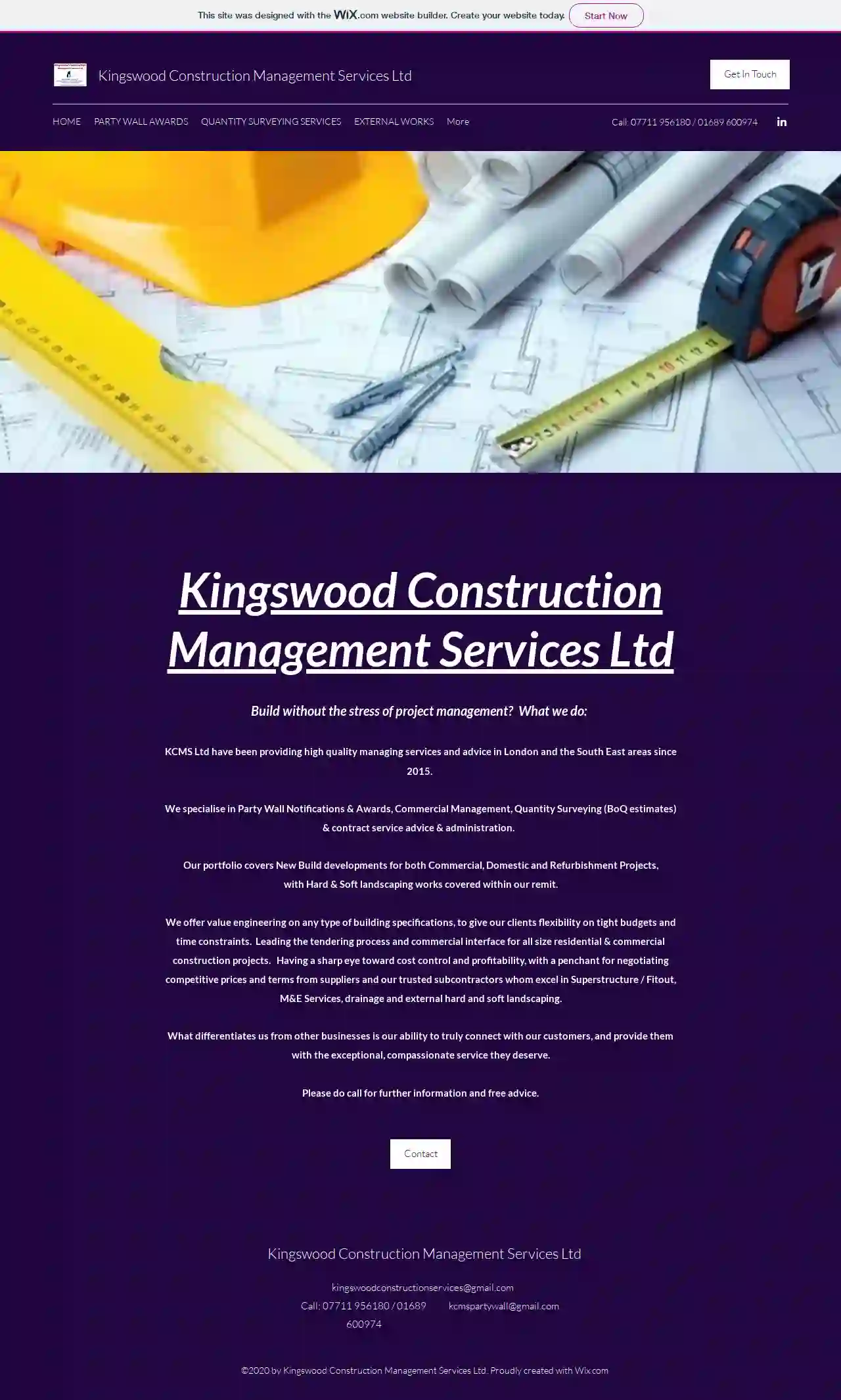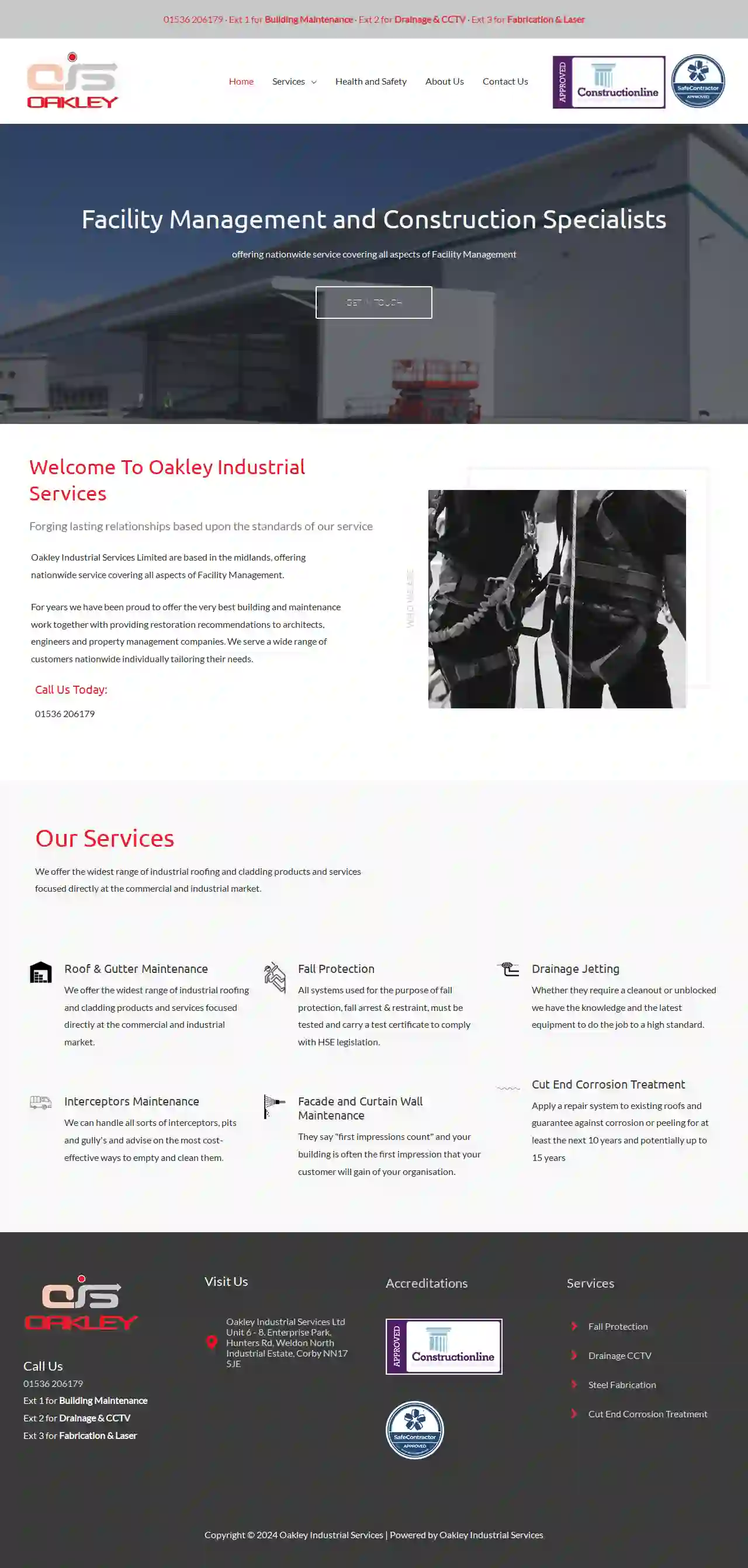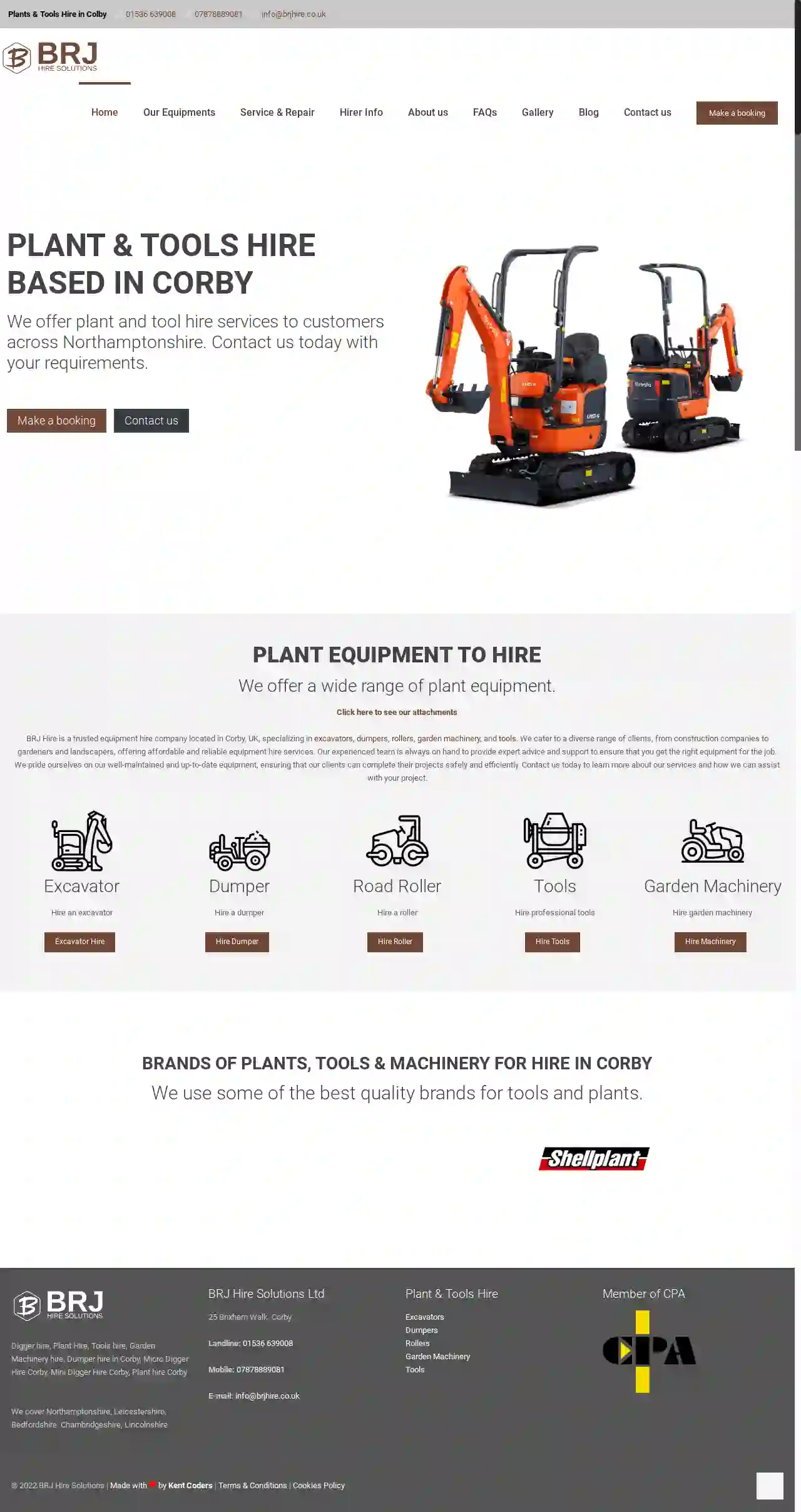Demolition Contractors Stoke Gifford
Top Demolition Contractors in Stoke Gifford
Get multiple Demolition Services quotes for your project today! Compare profiles, reviews, accreditations, portfolio, etc... and choose the best offer.

Kingswood Construction Management services ltd
Kingswood, GBKingswood Construction Management Services Ltd Build without the stress of project management? What we do: KCMS Ltd have been providing high quality managing services and advice in London and the South East areas since 2015. We specialise in Party Wall Notifications & Awards, Commercial Management, Quantity Surveying (BoQ estimates) & contract service advice & administration. Our portfolio covers New Build developments for both Commercial, Domestic and Refurbishment Projects, with Hard & Soft landscaping works covered within our remit. We offer value engineering on any type of building specifications, to give our clients flexibility on tight budgets and time constraints. Leading the tendering process and commercial interface for all size residential & commercial construction projects. Having a sharp eye toward cost control and profitability, with a penchant for negotiating competitive prices and terms from suppliers and our trusted subcontractors whom excel in Superstructure / Fitout, M&E Services, drainage and external hard and soft landscaping. What differentiates us from other businesses is our ability to truly connect with our customers, and provide them with the exceptional, compassionate service they deserve. Please do call for further information and free advice.
- Services
- Why Us?
- Gallery
Get Quote
General Building & Groundworks
Kingswood, GBWelcome to General Building & Groundworks I've been a sought-after general builder and ground worker in Gloucestershire and surrounding areas since 2018. I'm known for tackling everything from small repairs to large-scale projects. No matter the size of the job, I always work hard to ensure my clients are completely satisfied with my work. Get in touch today for a free consultation.
- Services
- Why Us?
- Gallery
Get Quote
Kingswood Canvas Ltd
4.323 reviewsUnits 8 & 9 Douglas Road Industrial Park, Kingswood, BS15 8PD, GBWelcome to Kingswood Canvas Kingswood Canvas is a leading manufacturer of high-quality PVC and canvas goods that are tailor-made to meet the unique needs of our customers. Our family-run business has been trading for over 40 years, and we take great pride in our commitment to excellence in product quality and customer service. We use the latest industrial stitching and high-frequency welding techniques to ensure that each product is built to last. And our electronic eyeleting machine provides a precise and secure finish every time. Additionally, we offer a plotting and cutting service for trade use only, and our experienced team can work with you to design the perfect product to meet your needs. At Kingswood Canvas, we are committed to providing our customers with the highest level of service and quality, and we look forward to working with you to create the perfect solution for your needs.
- Services
- Why Us?
- Gallery
Get Quote
Oakley Industrial Services Ltd
55 reviewsUnit 6 - 8, Enterprise Park, Hunters Rd, Weldon North Industrial Estate, Corby, NN17 5JE, GBFacility Management and Construction Specialists offering nationwide service covering all aspects of Facility Management Welcome To Oakley Industrial Services Forging lasting relationships based upon the standards of our service Oakley Industrial Services Limited are based in the midlands, offering nationwide service covering all aspects of Facility Management. For years we have been proud to offer the very best building and maintenance work together with providing restoration recommendations to architects, engineers and property management companies. We serve a wide range of customers nationwide individually tailoring their needs.
- Services
- Why Us?
- Gallery
Get Quote
Kingswood Landscapes
51 reviewsKingswood, GBWelcome to Kingswood Landscapes Established 27 years ago, Kingswood Landscapes has built a strong reputation for delivering high-quality landscaping services with unwavering professionalism. We take pride in every project, ensuring customer satisfaction is at the heart of everything we do. Explore our website to discover the wide range of services we offer, from creating stunning driveways and patios to transforming your garden with ponds, water features, and beautiful fencing. We also specialize in ornamental walls and arches, crazy paving, brick paving, and more. Contact us today to discuss your landscaping needs. We're here to help you create the outdoor space of your dreams.
- Services
- Why Us?
- Gallery
Get Quote
BRJ Hire Solutions
4.816 reviews25 Brixham Walk, Corby, England, NN18 8DS, GBBRJ Hire is a trusted equipment hire company located in Corby, UK, specializing in excavators, dumpers, rollers, garden machinery, and tools. We cater to a diverse range of clients, from construction companies to gardeners and landscapers, offering affordable and reliable equipment hire services. Our experienced team is always on hand to provide expert advice and support to ensure that you get the right equipment for the job. We pride ourselves on our well-maintained and up-to-date equipment, ensuring that our clients can complete their projects safely and efficiently. Contact us today to learn more about our services and how we can assist with your project.
- Services
- Why Us?
- Gallery
Get Quote
Kingswood Paving
58 reviewsKingswood, GB- Services
- Why Us?
Get Quote
Kingswood Drives and Patios
4.940 reviews10 Kipling Road, Corby, NN17 2DJ, GBAbout Kingswood Drives & Patios If you’re looking for the best driveway & landscaping services in Corby, Kettering, Market Harborough, Northampton & Surrounding Areas, then look no further than the team here at Kingswood Drives & Patios. Our extensive portfolio showcases the high standards we strive to achieve, so it’s not hard to see why we’re considered the leading providers of driveways, landscaping and paving in the area. Kingswood Drives & Patios are a professional Paving & Landscaping company established in Corby, Kettering, Market Harborough, Northampton & Surrounding Areas run by those with a wealth of experience in the industry. We pride ourselves on our commitment to provide a professional and speedy service at all times, whilst maintaining the highest quality of work. We are a family run business with a proven track record of quality workmanship, we carry out a variety of different services such as Resin, Block paving, Fencing, Driveway Entrance, Tarmac Driveways, Turfing, Landscaping all carried out to the highest standards.
- Services
- Why Us?
- Gallery
Get Quote
Cobley Countryside Services & Groundworks
4.73 reviewsCobley Lodge Farm, Little Oakley Corby Northamptonshire, Cobley Lodge FarmLittle Oakley Corby Northamptonshire, Corby, NN18 8HE, GBCobley Countryside Services & Groundworks Cobley Countryside Services (CCS) is a family-run business based in Northamptonshire with a rich history spanning five generations. We offer a comprehensive range of services specializing in groundworks, drainage, fencing, agricultural works, site clearance, and much more. Our expertise extends to various sectors, including Agriculture, Commercial, Estates, Public Sector, Educational, Equine, and Rural Residential Clients. At CCS, we take pride in our excellent reputation, reliability, and friendly approach to every project. We are committed to delivering high-quality workmanship and exceeding our clients' expectations.
- Services
- Why Us?
- Gallery
Get Quote
Kingswood Paving Contractors
4.833 reviewsKingswood, GB- Services
- Why Us?
Get Quote
Over 13,059+ Excavation Contractors in our network
Our excavation companies operate in Stoke Gifford and beyond!
ExcavationHQ has curated and vetted Top Excavation Businesses in Stoke Gifford. Find the most trustworthy pro today.
Frequently Asked Questions About Demolition Contractors
- Size and Complexity of the Structure: Larger and more complex structures, such as multi-story buildings, require more time, labor, and specialized equipment, increasing costs.
- Type of Demolition: Different demolition methods, such as implosion, wrecking ball, or high-reach demolition, have varying costs.
- Material Disposal: Disposal fees for demolition debris can contribute significantly to the overall cost, depending on the type and quantity of materials.
- Location and Accessibility: Demolition in densely populated areas or with limited access may require more planning and specialized equipment, affecting costs.
- Hazardous Materials: The presence of asbestos, lead paint, or other hazardous materials requires specialized removal and disposal procedures, adding to the expenses.
- Dust Suppression: Use water spraying, misting systems, or other dust suppression techniques to control airborne particles.
- Noise Barriers: Erect temporary noise barriers around the demolition site to reduce noise transmission to nearby properties.
- Work Schedule: Schedule noisy demolition activities during permitted hours to minimize disturbance to neighbors.
- Communication: Keep neighbors informed about the demolition schedule and any potential disruptions.
- General Liability Insurance: Covers bodily injury or property damage to third parties caused by the contractor's negligence.
- Workers' Compensation Insurance: Provides benefits to workers injured on the job.
- Pollution Liability Insurance: Covers costs associated with environmental contamination caused by demolition activities.
- Professional Liability Insurance: Protects against claims of negligence or errors in professional services, such as demolition planning or consulting.
What is a demolition bond?
How much does demolition cost in the UK?
How can I minimize the dust and noise from demolition?
What is the importance of insurance in demolition projects?
What is a demolition bond?
How much does demolition cost in the UK?
- Size and Complexity of the Structure: Larger and more complex structures, such as multi-story buildings, require more time, labor, and specialized equipment, increasing costs.
- Type of Demolition: Different demolition methods, such as implosion, wrecking ball, or high-reach demolition, have varying costs.
- Material Disposal: Disposal fees for demolition debris can contribute significantly to the overall cost, depending on the type and quantity of materials.
- Location and Accessibility: Demolition in densely populated areas or with limited access may require more planning and specialized equipment, affecting costs.
- Hazardous Materials: The presence of asbestos, lead paint, or other hazardous materials requires specialized removal and disposal procedures, adding to the expenses.
How can I minimize the dust and noise from demolition?
- Dust Suppression: Use water spraying, misting systems, or other dust suppression techniques to control airborne particles.
- Noise Barriers: Erect temporary noise barriers around the demolition site to reduce noise transmission to nearby properties.
- Work Schedule: Schedule noisy demolition activities during permitted hours to minimize disturbance to neighbors.
- Communication: Keep neighbors informed about the demolition schedule and any potential disruptions.
What is the importance of insurance in demolition projects?
- General Liability Insurance: Covers bodily injury or property damage to third parties caused by the contractor's negligence.
- Workers' Compensation Insurance: Provides benefits to workers injured on the job.
- Pollution Liability Insurance: Covers costs associated with environmental contamination caused by demolition activities.
- Professional Liability Insurance: Protects against claims of negligence or errors in professional services, such as demolition planning or consulting.